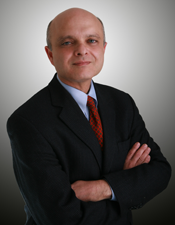Services
What is Colonoscopy?
Colonoscopy is a procedure in which your physician examines the colon lining, (large bowel), for abnormalities. This is done by inserting a flexible tube approximately as thick as your finger into the anus and advancing it slowly into the rectum and colon.
What preparation is required?
The colon must be completely clean for the procedure to be accurate and complete. Your physician will give you detailed dietary instructions and restrictions, and address the cleansing routine to be used. During the preparation, you generally consume a large volume of a special cleansing solution or several days of clear liquids, laxatives, and enemas prior to the examination. Follow your doctor's instructions carefully. If you do not, the procedure may have to be rescheduled.
What about my current medications?
Most medications may be continued as usual, but some can interfere with the preparation or the examination. Inform your physician of you current medications, and any allergies to medications several days prior to your visit. Aspirin products, arthritis medicines, anticoagulants (blood thinners), insulin, and iron products are examples. Inform your doctor if you require antibiotics prior to undergoing dental procedures, because you may need antibiotics prior to colonoscopy as well.
What can be expected during a Colonoscopy?
Colonoscopy is usually well tolerated and rarely causes much pain. There is often a feeling of pressure, bloating, or cramping at times during the procedure. Your doctor may medicate you through a vein to help you relax and tolerate procedural discomfort. You will be lying on your side or back while the colonoscope is advanced slowly through the large intestine. As the colonoscope is slowly withdrawn, the lining is again carefully examined. The procedure takes 15 to 60 minutes. In some cases, passage of the colonoscope through the entire colon to its junction with the small intestine cannot be achieved. The physician will decide if the limited exam is sufficient or if others are necessary.
What if the Colonoscopy shows something abnormal?
If your doctor thinks an area of the bowel needs to be evaluated in greater detail, a forceps instrument is passed through the colonoscope in order to obtain a biopsy (sample of the colon lining). This specimen is submitted to the pathology laboratory for analysis. If colonoscopy is used to identify bleeding sites, these are controlled through certain medications or by coagulation (sealing off bleeding vessels with heat treatment). If polyps are found, they are generally removed. None of these additional procedures typically produces pain. Remember, the biopsies are taken for many reasons and do not indicate that cancer is suspected.
What are polyps and why are they removed?
Polyps are abnormal growths from the lining of the colon that vary in size from a tiny dot too several inches. The majority of polyps are benign (non-cancerous) but the doctor cannot always tell a benign polyp from a malignant (cancerous) polyp by its outer appearance alone. For this reason, removed polyps are sent for tissue analysis. Removal of colon polyps is an important means of preventing colorectal cancer.
How are polyps removed?
Tiny polyps may be totally destroyed by fulguration (burning), but rather larger polyps are removed by a technique called snare polypectomy. The doctor passes a wire loop (snare) through the colonoscope and severs the attachment of the polyp from the intestinal wall by means of an electrical current. You should feel no pain during the polypectomy. There is a small risk that removing a polyp will cause bleeding or result in a burn to the wall of the colon, which could require emergency surgery.
What happens after a Colonoscopy?
After a colonoscopy, your physician will explain the results to you. If you have been given medications during the procedure, someone must accompany you home from the procedure because of the sedation used during the examination. Even if you feel alert after the procedure, your judgment and reflexes may be impaired by the sedation for the rest of the day, making it unsafe for you to drive or operate any machinery. You may have some cramping or bloating because of the air that is introduced into the colon during the examination. This should disappear quickly with the passage of flatus (gas). Generally, you should be able to eat after your procedure, but your doctor may restrict your diet and activities, especially after a polypectomy.
What are the possible implications of a Colonoscopy?
Colonoscopy and polypectomy are generally safe when performed by physicians who have been specially trained and are experienced in these endoscopic procedures. One possible complication is perforation or tears through the bowel wall that could require surgery. Bleeding may occur from the site of biopsy or polypectomy. It is usually minor and stops on its own or can be controlled through the colonoscope. Rarely, blood transfusions or surgery is required. Other potential risks include a reaction to the sedatives used and complications from heart or lung disease. Localized irritation of the vein where medications were injected may rarely cause a tender lump lasting for several weeks, but this will go away eventually.
Applying hot packs or hot moist towels may help relieve the discomfort. Although complications after a colonoscopy are uncommon, it is important for you to recognize early signs of any possible complication. Contact your physician who performed the colonoscopy if you notice any of the following symptoms: severe abdominal pain, fever and chills, or rectal bleeding of more than one-half cup. Bleeding can occur several days after the polypectomy.
Arrangements to get Home After the Test
If you are sedated, you will need to have someone accompany you home from the examination because sedatives may affect your judgment and reflexes for the rest of the day. Even if you do not feel tired, you will not be allowed to drive following the procedure.
For the patient
Because education is an important part of the comprehensive medical care, you have been provided with this information to prepare you for this procedure. If you have questions about your need for the colonoscopy, alternative tests, the cost of the procedure, methods of billing, or insurance coverage, do not hesitate to speak to your doctor or your doctor's office staff. Most endoscopists are highly trained specialists and welcome your questions regarding their credentials and training. If you have any questions that have not been answered, please discuss them with the endoscopic nurse or your physician before the examination begins.
What is Upper Endoscopy?
Upper Endoscopy (EGD) is a procedure that enables your physician to examine the lining of the upper part of your gastrointestinal tract i.e. the esophagus (swallowing tube), stomach, and duodenum (first portion of the small intestine) using a thin flexible tube with its own lens and light source.
Why is Upper Endoscopy done?
Upper Endoscopy is usually performed to evaluate symptoms of persistent upper abdominal pain, nausea, vomiting, or difficulty swallowing. It is also the best test for finding the cause of bleeding from the upper gastrointestinal tract. This procedure can detect early cancer and can distinguish between benign and malignant (cancerous) conditions when small samples of tissue of suspicious areas are obtained.
Possible medication adjustments
Before the test, be sure to discuss with your doctor whether you should adjust any of your usual medications before the procedure, any drug allergies you may have, and whether you have any other major diseases such as a heart or lung condition that may require special attention during the procedure. You should alert your doctor if you require antibiotics prior to undergoing dental procedures, since you may need antibiotics prior to Upper Endoscopy as well.
What preparation is required?
For the best (and safest) examination, the stomach must be completely empty. You should have nothing to eat or drink, including water, for approximately 6 hours before the examination. Your doctor will be more specific about the time of day that your test is scheduled.
Arrangements to get home after the test
If you are sedated, you will need to have someone accompany you home from the examination because sedatives may affect your judgment and reflexes for the rest of the day. Even if you do not feel tired, you will not be allowed to drive following the procedure.
What can be expected during the Upper Endoscopy?
Your doctor will review with you why Upper Endoscopy is being performed, whether any alternative test are available, and any possible complications from the procedure. Practices vary among doctors, but you may have your throat sprayed with a local anesthetic before the test begins and given medication through a vein to help you relax during the test. While you are in a comfortable position on your side, the endoscope is passed through the mouth and then through the esophagus, stomach, and duodenum. The endoscope does not interfere with your breathing during the test. Most patients consider the test to be slightly uncomfortable and many patients fall asleep during the procedure.
What happens after Upper Endoscopy?
After the test, you will be monitored in the Post Anesthesia Care Unit (PACU) until most of the effects of the medication have worn off. You throat may be a little sore for a while, and you may feel bloated because of the air introduced to your stomach during the test. You will be able to resume your diet after you leave the procedure area unless instructed otherwise. In most circumstances, your doctor can inform you of your test results on the day of your procedure; however, the results of any biopsies or cytology samples taken will take several days.
What are the posssible complications of the Upper Endoscopy?
Endoscopy is generally safe. Complications can occur but are rare when physicians with specialized training and experience in this procedure perform the test. Bleeding can occur from a biopsy site or where a polyp was removed. It is usually minimal and rarely requires a blood transfusion or surgery. Localized irritation of the vein where the medication was injected may rarely cause a tender lump lasting several weeks, but this will go away eventually. Applying heat packs or moist hot towels may help relieve discomfort. Other potential risks include a reaction to the sedatives used and complications from heart or lung diseases. Major complications, such as perforation (a tear that might require surgery for repair), are very uncommon.
It is important for you to recognize early signs of any possible complication. If you begin to run a fever after the test, have trouble swallowing, or have increasing throat, chest, or abdominal pain, let your doctor know promptly.
For the patient
Because education is an important part of comprehensive medical care, you have been provided with this information to prepare you for this procedure. If you have any questions about your need for the Endoscopy, alternative tests, costs, billing methods, insurance coverage, or any other inquiries, do not hesitate to call your doctor or your doctor's office staff. Most endoscopists are highly trained specialists and welcome your questions regarding their credentials and training. If you have any unanswered questions, please discuss them with the endoscopic nurse or your physician before the examination begins.
IV Infusion
Capsule Endoscopy
Capsule Endoscopy is a non-invasive, high quality, disposable, diagnostic imaging device for the use in the gastrointestinal tract. Capsule Endoscopy uses a disposable miniature video camera contained in a capsule (Camera Pill Endoscope) that is ingested by the patient. It is propelled by peristalsis to naturally move through the digestive tract. The Camera Pill contains a complete optical system with a video chip, light source, transmitter, and energy source designed specifically for direct imaging within the intestinal tract. The camera takes two images per second, which is approximately 50,000 pictures in a 8 hour period. It transmits the data to a recording device worn around the waist of the patient.
Once the study is completed, the recording device is connected to a computer whose software provides the images to the computer screen. The procedure is ambulatory, allowing patients to continue daily activities throughout the endoscopic examination.
What Preparation is Required?
Basically, for capsule endoscopy, the patient has to fast for at least ten hours prior to the procedure. The day before the procedure it is essential that liquid diet be maintained starting at 8:00p.m. and nothing to eat or drink after midnight.
What about My Current Medications?
Most medications may be continued as usual, but some can interfere with the preparation or the examination. Inform your physician of your current medications several days prior to your visit. Aspirin products, arthritis medicines, anticoagulants (blood thinner such as Coumadin), insulin and iron products are examples. It is advised not to take any medications before the procedure. However, some medications can be resumed 4 hours after ingesting the capsule EXCEPT anticoagulants, Aspirin, NSAIDs.
The Day of the Procedure?
Please come to the facility at your scheduled time. Wear loose fit clothing such as sweat pants. Once you are registered, and all the proper connections have been made, you are ready to swallow the pill. The capsule is the size of a vitamin pill and will be swallowed with a cup of water.
What is Expected after Ingesting the Capsule?
You may drink clear liquids (water, apple juice) 2 hours after swallowing the pill. You may eat a light snack 4 hours after ingesting the pill, and 8 hours after, you may resume your regular diet. Avoid exercise and heavy lifting. You may walk, sit, lie down, and drive a car. If your job allows avoiding unsuitable environment or physical movements, then you can return to work. Avoid going near MRI machines and other equipment that have high frequency waves. DO NOT remove sensor array leads, and avoid getting them wet. Return to the facility the next day before 10:00am.
Please notify your physician if you experience severe or persistent abdominal pain, chest pain, fever, difficulty swallowing or if you have any questions.
Billing and Insurance
Capsule Endoscopy is a new procedure, some insurance companies may not cover the entire bill, therefore, patient may be responsible for part of the bill. Physician fees are separate from the facility's fee. Because patient will be carrying part of the instrument with them, there will be a $200.00 retaining fee. For your convenience, we accept cash, checks, VISA, MasterCard and Discover Card. Please note that the retaining fee will be reimbursed once the equipment is returned to the facility. If you have any questions regarding your bill, please feel free to call us.











